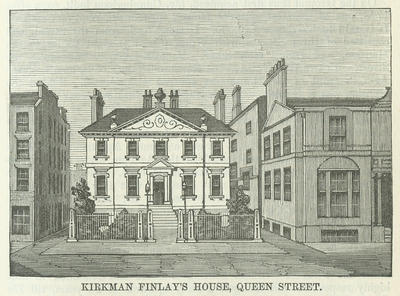
An illustration of Kirkman Finlay's house on Queen Street. Finlay bought the mansion from James Ritchie of Busby, a tobacco merchant and a partner in the Thistle Bank. By 1873 the National Bank Buildings occupied the three plots on Queen Street that are shown here.
Finlay (1773-1842) was born in the Gallowgate, the son of a merchant. He took sole control of James Finlay & Son at the age of 18 following his father's death and built a thriving cotton spinning business. He was also one of the first merchants in Britain to challenge the supremacy of the East India Company in trade with India and the Far East.
Finlay was elected Lord Provost of Glasgow in 1812 and a few days later became MP for the Clyde Burghs. His campaign to challenge the East India Company's domination of Britain's trade with India and the Far East was popular with merchants in the Glasgow area. However, an angry mob smashed the windows of his home after he voted in favour of the Corn Laws in 1815.
After his death, a marble statue of Finlay was placed on the staircase at the Merchants' House on Hutcheson Street.
Reference: Mitchell Library, GC 941.435 GOR
Reproduced with the permission of Glasgow City Council, Libraries Information and Learning
Keywords:
bankers, banks, Clyde Burghs, corn laws, cotton manufacturers, cotton merchants, cotton spinning, exports, Lord Provosts, Members of Parliament, MPs, National Bank, rectors, riots, tea importers, tea merchants, textile manufacturers, Thistle Bank
You have 0 images in your photo album.